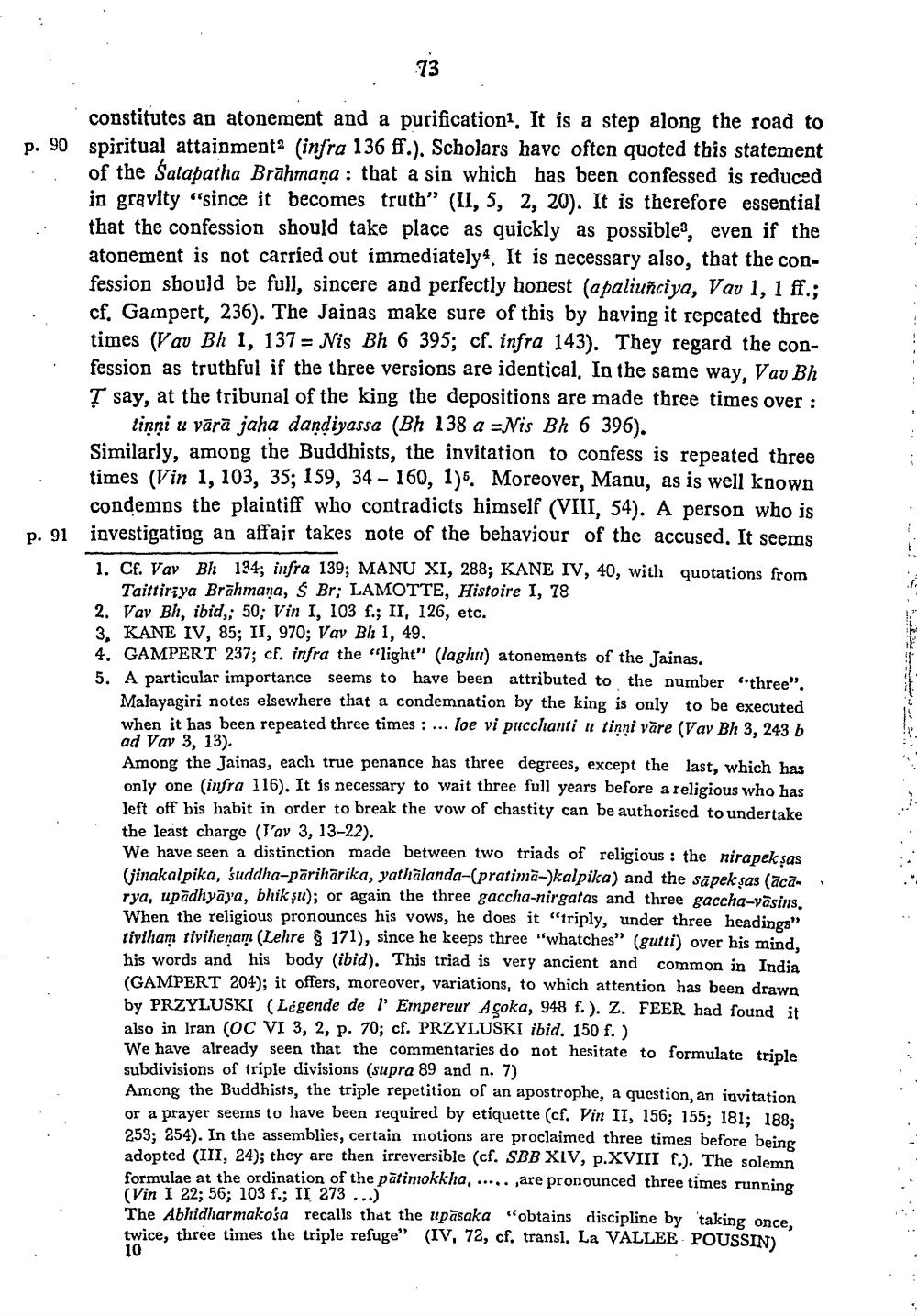________________
73
p. 90
Spiri
.--
.-
....
p. 91
.
constitutes an atonement and a purification?. It is a step along the road to spiritual attainment (infra 136 ff.). Scholars have often quoted this statement of the Salapatha Brāhmana : that a sin which has been confessed is reduced in gravity "since it becomes truth" (II, 5, 2, 20). It is therefore essential that the confession should take place as quickly as possibles, even if the atonement is not carried out immediately. It is necessary also, that the confession should be full, sincere and perfectly honest (apaliuñciya, Vav 1, 1 ff.; cf, Gampert, 236). The Jainas make sure of this by having it repeated three times (Vav Bh I, 137 = Nis Bh 6 395; cf, infra 143). They regard the confession as truthful if the three versions are identical. In the same way, Vav Bh I say, at the tribunal of the king the depositions are made three times over :
tinni u vārā jaha dandiyassa (Bh 138 a =Nis Bh 6 396). Similarly, among the Buddhists, the invitation to confess is repeated three times (Vin 1, 103, 35; 159, 34 - 160, 1)5. Moreover, Manu, as is well known condemns the plaintiff who contradicts himself (VIII, 54). A person who is investigating an affair takes note of the behaviour of the accused. It seems 1. Cf. Vay Bh 134; infra 139; MANU XI, 288; KANE IV, 40, with quotations from
Taittiriya Brāhmaṇa, Ś Br; LAMOTTE, Histoire I, 78 2. Vay Bh, ibid,; 50; Vin I, 103 f.; II, 126, etc. 3. KANE IV, 85; II, 970; Vay Bh 1, 49. 4. GAMPERT 237; cf. infra the "light" (lagh) atonements of the Jainas. 5. A particular importance seems to have been attributed to the number three".
Malayagiri notes elsewhere that a condemnation by the king is only to be executed when it has been repeated three times : ... loe vi pucchanti u tinni vāre (Vav Bh 3, 243 b ad Vay 3, 13). Among the Jainas, each true penance has three degrees, except the last, which has only one (infra 116). It is necessary to wait three full years before a religious who has left off his habit in order to break the vow of chastity can be authorised to undertake the least charge (j'ay 3, 13-22). We have seen a distinction made between two triads of religious : the nirapek sas (jinakalpika, suddha-pārihārika, yathalanda-(pratima--)kalpika) and the sāpek şas (ācā. rya, upadhyāya, bhikṣu); or again the three gaccha-nirgatas and three gaccha-yasins. When the religious pronounces his vows, he does it "triply, under three headings" tiviham tivihenam (Lehre & 171), since he keeps three "whatches" (gutti) over his mind, his words and his body (ibid). This triad is very ancient and common in India (GAMPERT 204); it offers, moreover, variations, to which attention has been drawn by PRZYLUSKI (Légende de l'Empereur Açoka, 948 f.). Z. FEER had found it also in Iran (OC VI 3, 2, p. 70; cf. PRZYLUSKI ibid. 150 f.) We have already seen that the commentaries do not hesitate to formulate triple subdivisions of triple divisions (supra 89 and n. 7) Among the Buddhists, the triple repetition of an apostrophe, a question, an invitation or a prayer seems to have been required by etiquette (cf. Vin II, 156; 155; 181; 188: 253; 254). In the assemblies, certain motions are proclaimed three times before being adopted (111, 24); they are then irreversible (cf. SBB XIV, p.XVIII f.). The solemn formulae at the ordination of the pātimokkha, .....,are pronounced three times running (Vin I 22; 56; 103 f.; II 273 ...) The Abhidharmakosa recalls that the upāsaka "obtains discipline by taking once. twice, three times the triple refuge" (IV, 72, cf, transl, La VALLEE POUSSIN) 10
.
.
25. prayer" Buddhiste division




